As we enter the final days of the 2020 election, the basic structure of the race remains largely the same as it has since the beginning of the summer. While Trump clearly had a better debate performance on Thursday night than his prior one, Biden did well enough that it is unlikely to impact the outcome of the race.
Timing is everything in politics and while Trump tapped into the mood of the country in 2016 with his message of disappointment and anger, Biden’s ability to offer empathy and compassion seems to be more effective for today.
Nevertheless, there is now a coherent Trump strategy for victory. And Trump continues to perform better in the states that will determine the winner of the election than he does at the national level. Given the history of the 2016 campaign, it would be unwise to discount Trump’s ability to turn his campaign around in the final days of the race. Trump has a much more aggressive campaign schedule than Biden. He is drawing large crowds and is dominating local coverage in the battleground states where he is campaigning.
COVID-19
The 2020 presidential campaign will be remembered as the coronavirus election. This pandemic caused the greatest health care crisis in our country in over 100 years and the most significant economic downturn since the Great Depression. The battleground states that will determine the outcome of a close election have been hit particularly hard by the coronavirus.
In the past two days, the country has averaged more than 83,700 new cases, a record high. In the past week, at least 35 states have set records for new cases. More than 41,000 people are currently hospitalized, which is a 40% increase in the past month.
Bowing to the on-the-ground realities of the widespread transmission across the country, the White House Chief of Staff Mark Meadows admitted Sunday on national television that “we are not going to control the pandemic.”
Trump's ratings on his handling of the virus have been consistently in the low 40s. In a New York Times poll released this week, Biden has a 12% advantage over Trump (52% to 40%) in who would do a better job of managing the coronavirus. And as difficult as life has been since the outbreak of the pandemic, all signs suggest the country is approaching a much more dangerous phase as we enter the fall influenza season. The most recent projections by the University of Washington Institute for Health Metrics and Evaluation predicts that there could be nearly 400,000 deaths in the U.S. by February 1st.
The public shares the same concerns about the future as the scientists who are projecting this sharp increase in coronavirus cases. In the New York Times poll released this week, half of our country (51%) thinks that the worst is yet to come, with 56% of seniors fearing the upcoming months.
Economic Uncertainty
In the midst of a deep recession for many Americans, the stock market continues to reach new highs. This tale of two Americas is reflected in the Conference Board's release of CEO and consumer confidence in the economy. Their recently released report shows a wide gap between CEOs’ optimistic expectations for the future compared to the overall negative sentiments of the American consumer.
A new poll by the Associated Press-NORC Center For Public Affairs Research released this week shows the economic and psychological toll that the virus has taken on the American public. Seventy percent of respondents reported that juggling their jobs and other responsibilities amid the contagion is a source of stress in their lives and 28% say they are working fewer hours due to the virus.
And as the virus continues to get worse, Americans who are struggling financially will soon see their temporary financial safety net ending.
At the end of the year the U.S. Centers for Disease Control and Prevention’s nationwide eviction moratorium for rentals is due to expire, as is the moratorium of foreclosures on homes that failed to make mortgage payments. In addition, supplemental state unemployment benefits for independent contractors and gig workers will end and the extension in the pause of student loan payments also expires. Lastly, expanded sick and family medical leave, which had been extended until the end of the year, is also scheduled to be terminated.
Trump’s Strategy for Victory
It is clear that Trump and his campaign settled on their strategy for the closing days of the campaign. Rather than trying to defend the past four years, they are trying to make this election a choice between Trump, a political outsider, and Biden, the insider candidate of the status quo based on his 47 years in government. This was their strategy in the last debate, which is now reflected in the television ads that they are running and Trump’s final stump speeches.
At the core of their argument, they cast Biden‘s policies as raising taxes, eliminating the oil and gas industry, which will raise energy prices, taking away private insurance, and cutting entitlement programs—all of which they say will lead to fewer jobs and lower incomes.
This strategy seems to be working, at least with his base, as Trump raised $26 million in the 24 hours following Thursday’s debate.
Trump is adopting this strategy as we have now completed a political realignment in our country that began forming in the early 1990’s. While Trump did not cause this realignment, his presidency has accelerated its conclusion. In this post-realignment world, there are now four factors which drive our politics: age, race, gender and, most importantly, education.
As college-educated, suburban, and independent voters have drifted away from Trump and the Republican Party in massive numbers, the GOP is now even more dependent on non-college-educated white voters to win elections.
Trump was absolutely correct when he boasted last week that “we have the strongest base probably ever in politics” which is fuelled largely by these non-college-educated white voters. These voters in Michigan, Pennsylvania and Wisconsin have remained a primary focus of his presidency and are central to his re-election strategy.
This strategy is predicated on outpacing the changing demographics that are transforming our country. It is clear that it is only a matter of time before these voters become increasingly less important in determining the outcome of elections in our country.
Even in the Rust Belt states that were key to Trump’s victory in 2016, there has been a decrease of white voters with no college degree since 2016.
As we enter the final days of the 2020 election, the basic structure of the race remains largely the same as it has since the beginning of the summer. While Trump clearly had a better debate performance on Thursday night than his prior one, Biden did well enough that it is unlikely to impact the outcome of the race.
Timing is everything in politics and while Trump tapped into the mood of the country in 2016 with his message of disappointment and anger, Biden’s ability to offer empathy and compassion seems to be more effective for today.
Nevertheless, there is now a coherent Trump strategy for victory. And Trump continues to perform better in the states that will determine the winner of the election than he does at the national level. Given the history of the 2016 campaign, it would be unwise to discount Trump’s ability to turn his campaign around in the final days of the race. Trump has a much more aggressive campaign schedule than Biden. He is drawing large crowds and is dominating local coverage in the battleground states where he is campaigning.
COVID-19
The 2020 presidential campaign will be remembered as the coronavirus election. This pandemic caused the greatest health care crisis in our country in over 100 years and the most significant economic downturn since the Great Depression. The battleground states that will determine the outcome of a close election have been hit particularly hard by the coronavirus.
In the past two days, the country has averaged more than 83,700 new cases, a record high. In the past week, at least 35 states have set records for new cases. More than 41,000 people are currently hospitalized, which is a 40% increase in the past month.
Bowing to the on-the-ground realities of the widespread transmission across the country, the White House Chief of Staff Mark Meadows admitted Sunday on national television that “we are not going to control the pandemic.”
Trump's ratings on his handling of the virus have been consistently in the low 40s. In a New York Times poll released this week, Biden has a 12% advantage over Trump (52% to 40%) in who would do a better job of managing the coronavirus. And as difficult as life has been since the outbreak of the pandemic, all signs suggest the country is approaching a much more dangerous phase as we enter the fall influenza season. The most recent projections by the University of Washington Institute for Health Metrics and Evaluation predicts that there could be nearly 400,000 deaths in the U.S. by February 1st.
The public shares the same concerns about the future as the scientists who are projecting this sharp increase in coronavirus cases. In the New York Times poll released this week, half of our country (51%) thinks that the worst is yet to come, with 56% of seniors fearing the upcoming months.
Economic Uncertainty
In the midst of a deep recession for many Americans, the stock market continues to reach new highs. This tale of two Americas is reflected in the Conference Board's release of CEO and consumer confidence in the economy. Their recently released report shows a wide gap between CEOs’ optimistic expectations for the future compared to the overall negative sentiments of the American consumer.
A new poll by the Associated Press-NORC Center For Public Affairs Research released this week shows the economic and psychological toll that the virus has taken on the American public. Seventy percent of respondents reported that juggling their jobs and other responsibilities amid the contagion is a source of stress in their lives and 28% say they are working fewer hours due to the virus.
And as the virus continues to get worse, Americans who are struggling financially will soon see their temporary financial safety net ending.
At the end of the year the U.S. Centers for Disease Control and Prevention’s nationwide eviction moratorium for rentals is due to expire, as is the moratorium of foreclosures on homes that failed to make mortgage payments. In addition, supplemental state unemployment benefits for independent contractors and gig workers will end and the extension in the pause of student loan payments also expires. Lastly, expanded sick and family medical leave, which had been extended until the end of the year, is also scheduled to be terminated.
Trump’s Strategy for Victory
It is clear that Trump and his campaign settled on their strategy for the closing days of the campaign. Rather than trying to defend the past four years, they are trying to make this election a choice between Trump, a political outsider, and Biden, the insider candidate of the status quo based on his 47 years in government. This was their strategy in the last debate, which is now reflected in the television ads that they are running and Trump’s final stump speeches.
At the core of their argument, they cast Biden‘s policies as raising taxes, eliminating the oil and gas industry, which will raise energy prices, taking away private insurance, and cutting entitlement programs—all of which they say will lead to fewer jobs and lower incomes.
This strategy seems to be working, at least with his base, as Trump raised $26 million in the 24 hours following Thursday’s debate.
Trump is adopting this strategy as we have now completed a political realignment in our country that began forming in the early 1990’s. While Trump did not cause this realignment, his presidency has accelerated its conclusion. In this post-realignment world, there are now four factors which drive our politics: age, race, gender and, most importantly, education.
As college-educated, suburban, and independent voters have drifted away from Trump and the Republican Party in massive numbers, the GOP is now even more dependent on non-college-educated white voters to win elections.
Trump was absolutely correct when he boasted last week that “we have the strongest base probably ever in politics” which is fuelled largely by these non-college-educated white voters. These voters in Michigan, Pennsylvania and Wisconsin have remained a primary focus of his presidency and are central to his re-election strategy.
This strategy is predicated on outpacing the changing demographics that are transforming our country. It is clear that it is only a matter of time before these voters become increasingly less important in determining the outcome of elections in our country.
Even in the Rust Belt states that were key to Trump’s victory in 2016, there has been a decrease of white voters with no college degree since 2016.
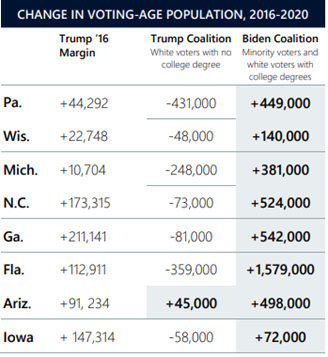 Source: The New York Times, Census Current Population Survey, IPUMS-CPS, University of Minnesota
Source: The New York Times, Census Current Population Survey, IPUMS-CPS, University of Minnesota
Nevertheless, the nonpartisan States of Change projects that non-college-educated whites are still expected to comprise 60% of the voters in Iowa, 55% in Wisconsin, 52% in Ohio, 51% in Michigan, and 48% in Pennsylvania in the upcoming election.
An analysis by David Wasserman of the Cook Political Report clearly shows the upside opportunity for Trump with these voters in the Rust Belt.
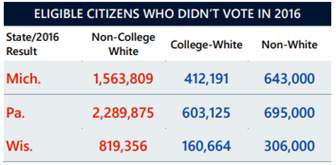 Source: Dave Wasserman, Cook Report
Source: Dave Wasserman, Cook Report
There is also evidence that Trump continues to make headway in engaging these voters. Since the primaries, Republicans have out-registered the Democrats in signing up new voters in several battleground states, including Pennsylvania, where Republicans have closed the gap by about 134,000 people compared to 2016.
The Electoral College
Biden continues to maintain a substantial lead well above the 270 votes needed in the electoral college as we head into the final days of the campaign. In the most recent non-partisan 270toWin analysis, Biden is currently leading in states totalling 290 votes with five states and two congressional districts totalling 85 electoral votes considered toss ups.
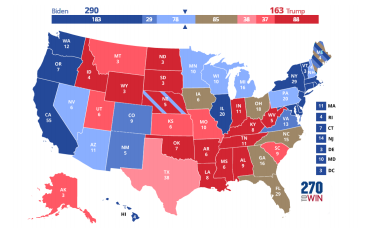
Battleground States
Biden continues to lead Trump in the battleground states, polling near or above 50% in most of these states. Biden is winning or tied in states that were not close in 2016.
Trump is now having difficulty in Texas and Iowa, states that he won by 9% in 2016, in Ohio where he won by 8%, in Georgia where he won by 5%, and in Arizona and North Carolina where he won by 3.5%. In most of these states, Trump's share of the vote remains in the mid 40's, far short of the 50% that he needs to win in a two-person race.
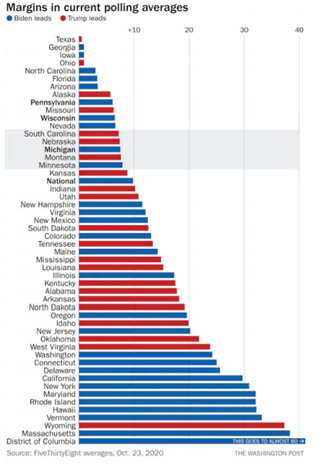 Source: The Washington Post
Source: The Washington Post
Money in the Presidential Election
Biden has enjoyed a significant fundraising advantage over Trump, having outraised him by $375 million dollars in the past ten weeks.
This differential has enabled Biden to vastly outspend Trump on television ads since the beginning of the summer. According to Advertising Analytics, Biden will air $178 million more in television ad buys from June 1st through Election Day than Trump.
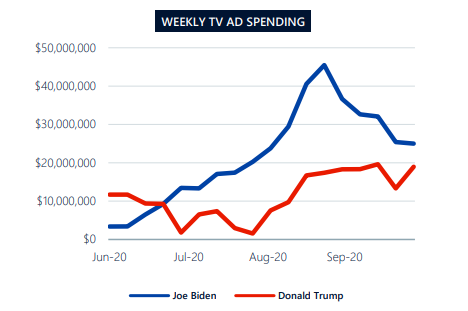 Source: Kantar/CMAG, The Wall Street Journal
Source: Kantar/CMAG, The Wall Street Journal
Biden's cash advantage has been aided by a substantial boost by outside groups that have overwhelmed Trump and the GOP with television ads since the beginning of the summer.
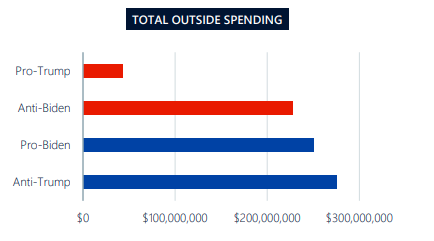 Source: OpenSecrets
Source: OpenSecrets
Biden will continue to have a significant financial advantage over Trump for the remainder of the campaign. As of October 14th, Biden, the DNC, and affiliated committees had $331.2 million in cash compared to only $223.6 million for Trump, the RNC and their two affiliated committees.
Early Voting
All signs point to record levels of voting with Democrats continuing to show a significant edge in early voting. As of today, 59,035,218 people have voted, which is approaching 40% of the total vote cast in 2016. The non-partisan TargetSmart data firm projects that Democrats currently have nearly a 10-point advantage over Republicans in the early voting thus far.
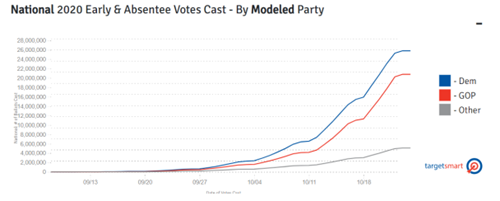 Source: TargetSmart
Source: TargetSmart
In an analysis by Hawkfish, a progressive data firm funded by Mike Bloomberg, the Democrats are not only leading in early voting, but they are also racking up these large numbers with a high percentage of low frequency and newly registered voters.
In their analysis of early voting in Tier 1 battleground states, Democrats are leading by a margin of 46% in Pennsylvania, 24% in Michigan, 22% in Wisconsin, 16% in Arizona, 14% in North Carolina, and 10% in Florida.
It was expected that Democrats would build large leads in the early voting by mail and that the Republicans would narrow those margins when the in-person early voting started across the country. The in-person early voting that began in Florida last week confirms these predictions as the Republicans narrowed the Democratic margin by over 20% in just three days of in-person early voting.
U.S. Senate
The Democrats continue to have the momentum in Senate races across the country. At a fundraiser this week President Trump was quoted as saying that it will be “very tough” for the Republicans to keep control of the Senate. The Democrats are ahead and favored to pick up Arizona and Colorado, continue to maintain a lead in Maine and North Carolina, and are ahead or within the margin of error in both Georgia races, Iowa, Montana, South Carolina, Kansas, and Alaska.
Supreme Court
The Senate has scheduled a final vote on the Judge Amy Coney Barrett nomination on Monday.
What We Are Reading
The Wall Street Journal
Coronavirus Deaths, Job Losses Hit Pennsylvania Hardest of 2020 Battlegrounds
By John McCormick
The Wall Street Journal
A Good Debate, and It’s Not Quite Over
By Peggy Noonan
The New York Times
The Relentless Shrinking of Trump’s Base
By Ford Fessenden and Lazaro Gamio
The Washington Post
Pennsylvania, Michigan and Wisconsin still hold the keys to 2020
By Dan Balz
POLITICO
‘Warning Flare’: New Swing-State Data Shows Massive Democratic Early-Vote Lead
By Marc Caputo and Zach Montellaro
